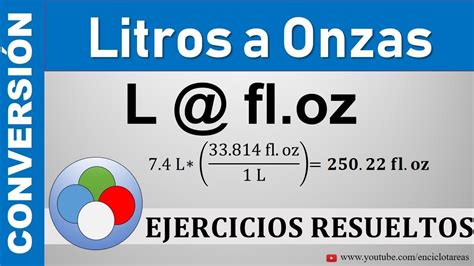Cuanto Es Un Litro En Oz
Kalali
Mar 31, 2025 · 4 min read

Table of Contents
How Many Ounces Are in a Liter? A Comprehensive Guide
Understanding unit conversions is crucial in various aspects of life, from cooking and baking to scientific experiments and international trade. One common conversion that often causes confusion is the relationship between liters (L) and ounces (oz). This comprehensive guide will delve deep into the conversion of liters to ounces, exploring the different types of ounces, providing practical examples, and offering tips to avoid common mistakes.
Understanding Liters and Ounces:
Before diving into the conversion, let's briefly define the units involved:
-
Liter (L): A metric unit of volume, commonly used for liquids. It's a base unit in the International System of Units (SI). One liter is equivalent to 1 cubic decimeter (dm³).
-
Ounce (oz): A unit of volume and mass (weight). This is where things get a little tricky. There are two main types of ounces:
- Fluid Ounce (fl oz): A unit of volume, specifically for liquids. This is the type of ounce usually used in conversion with liters.
- Ounce (oz) as a unit of weight: This refers to avoirdupois ounces, a unit of mass in the imperial system. It's important to distinguish this from the fluid ounce when dealing with volume conversions. We'll focus primarily on fluid ounces in this article.
The Conversion Factor: Liters to Fluid Ounces
The key to converting liters to fluid ounces is understanding the conversion factor. One liter is approximately equal to 33.814 fluid ounces (fl oz). This is a crucial number to remember.
The Calculation: Liters to Fluid Ounces
To convert liters to fluid ounces, simply multiply the number of liters by the conversion factor:
Fluid Ounces = Liters × 33.814
Let's illustrate with a few examples:
-
Example 1: Converting 1 Liter to Fluid Ounces
1 Liter × 33.814 fl oz/L = 33.814 fl oz
-
Example 2: Converting 2.5 Liters to Fluid Ounces
2.5 Liters × 33.814 fl oz/L = 84.535 fl oz
-
Example 3: Converting 0.5 Liters to Fluid Ounces
0.5 Liters × 33.814 fl oz/L = 16.907 fl oz
Practical Applications:
Understanding this conversion is essential in various real-world scenarios:
-
Cooking and Baking: Many international recipes use metric measurements (liters). Converting to fluid ounces ensures accurate measurements when using customary units.
-
Travel: When traveling internationally, it's helpful to understand volume conversions for liquids such as bottled water or beverages.
-
Scientific Experiments: In labs, precise measurements are crucial. Knowing how to convert between liters and fluid ounces ensures accuracy in experiments.
-
Everyday Life: From purchasing beverages to understanding product labels, this conversion can help you comprehend volumes accurately.
Common Mistakes to Avoid:
-
Confusing Fluid Ounces and Weight Ounces: This is the most common mistake. Always ensure you're using the correct type of ounce (fluid ounce) when converting from liters.
-
Incorrect Conversion Factor: Using an inaccurate conversion factor will lead to errors. Remember the key conversion: 1 liter ≈ 33.814 fluid ounces.
-
Rounding Errors: While it's fine to round for practical purposes, avoid excessive rounding, especially in scientific contexts, to maintain accuracy.
Advanced Concepts and Variations:
While the standard conversion factor is generally sufficient, there are some nuances:
-
Different Definitions of the Fluid Ounce: Slight variations in the definition of a fluid ounce exist in different countries. The conversion factor we use (33.814) is based on the US fluid ounce. For the UK fluid ounce, the conversion factor is slightly different.
-
Metric Prefixes: Remember that liters can be expressed using metric prefixes like milliliters (mL), kiloliters (kL), etc. This requires additional conversion steps using the appropriate metric prefixes.
Beyond the Basic Conversion: Exploring Related Conversions
Once you master the liter-to-fluid ounce conversion, you can build upon this knowledge to tackle more complex conversions. For example:
-
Liters to Gallons: Since you know how many fluid ounces are in a liter, and you know how many fluid ounces are in a gallon (128 fl oz), you can easily create a conversion factor for liters to gallons.
-
Liters to Cubic Centimeters: Since a liter is equivalent to 1000 cubic centimeters (cc or cm³), converting between these units is straightforward.
-
Fluid Ounces to Milliliters: You can use the liter-to-fluid ounce conversion in conjunction with the liter-to-milliliter conversion to create a fluid ounce-to-milliliter conversion.
Conclusion:
Understanding the conversion between liters and fluid ounces is a valuable skill with applications across various fields. By grasping the conversion factor, avoiding common mistakes, and exploring related conversions, you can confidently navigate the world of volume measurements and ensure accuracy in your calculations. Remember to always be mindful of the unit type (fluid ounce vs. weight ounce) to prevent errors and to utilize appropriate rounding practices for the given context. With practice, this conversion will become second nature, making your measurements more precise and efficient.
Latest Posts
Latest Posts
-
What Is 10 Out Of 15
Apr 02, 2025
-
How Do You Copy A Line Segment
Apr 02, 2025
-
Food Chain In The Tropical Rainforest
Apr 02, 2025
Related Post
Thank you for visiting our website which covers about Cuanto Es Un Litro En Oz . We hope the information provided has been useful to you. Feel free to contact us if you have any questions or need further assistance. See you next time and don't miss to bookmark.
